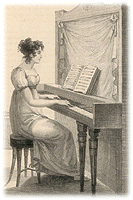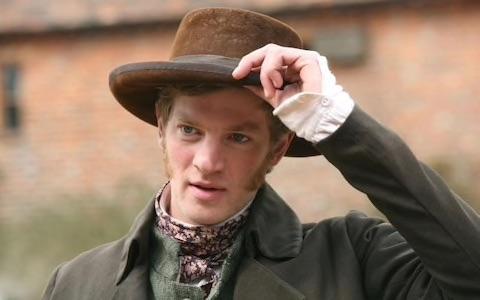Jane Austen's Life: George Austen
Jane Austen to Cassandra, December 27, 1808
 One of the many things that made me love Becoming Jane was the interaction between Jane Austen and her brothers in the movie. Granted, the movie only included Henry Austen and George Austen there, and left Jane’s other brothers in the conversations only. But it was very important to me that George Austen, of all people, was included. People who have read JA biographies would learn that George was a forgotten son in the Austen family due to his mental incapability.
One of the many things that made me love Becoming Jane was the interaction between Jane Austen and her brothers in the movie. Granted, the movie only included Henry Austen and George Austen there, and left Jane’s other brothers in the conversations only. But it was very important to me that George Austen, of all people, was included. People who have read JA biographies would learn that George was a forgotten son in the Austen family due to his mental incapability.
After reading more info about George, I was glad that Julian Jarrold decided to include George in the movie, paying homage to Jane’s abandoned brother. So, this is a short article and a tribute to George Austen. George Austen (1766 – 17 January 1838) was actually the second son of Revd. George Austen and Cassandra Leigh. He was born with a mental handicap; hence he was kept away from the rest of the Austen family. It was one of the dark secrets of the Austens that David Nokes elaborated in his 1997 biography, Jane Austen: a Life. However, Claire Tomalin’s book (2000) of the same title recalled George in a slightly different light; George still had the luxury of becoming the godson of Mr. Hancock (Eliza De Feullide’s father).

Tomalin noted that George, who possibly suffered cerebral palsy, still lived in Steventon as a child. On November 8th, 1772, Mrs. Austen wrote to her relative Ms. Susannah Walter that she was at home with her four sons; that would mean that George was still in Steventon in 1772, with James, Edward and Henry. However, in 1779 a decision was made to trust George to a Culham family who lived in Monk Sherborne, about three miles from Basingstoke (Nokes’s version was Cullum, instead of Culham). George would later spend his entire seventy-two years there with his uncle, Mr. Thomas Leigh (brother of Jane’s mother Cassandra Leigh), who also suffered mental setbacks. Hence, based on Tomalin’s analysis, brother George Austen was still in Steventon when Tom Lefroy met Jane Austen during the 1795 Christmas holiday, as portrayed in Becoming Jane.
George Austen was rarely mentioned in the Austen family letters, except on the odd occasion, e.g. in a letter of July 8th, 1770 where Mr. Austen wrote to Susannah Walter that ‘We have this comfort, he cannot be a bad or a wicked child’ (Tomalin 2000, p. 8). However, the Austens seldom visited George in Monk Sherborne. At best, James Austen paid Mr. Francis Cullum a routine visit to give the latter the Austens’ contribution for George’s expenses (Nokes 1997). I am not sure if there is any letter of Jane talking about his brother George (she talked of other George, i.e. her nephew in Letter #60 (24-25 October 1808)(Faye 1997), but Tomalin mentioned that Jane Austen knew deaf and dumb sign language, as observed in her letter from the year 1808 (she talked ‘with my fingers’), hence it is possible that Jane sometimes interacted with Brother George in real life; or at least wrote about him in the confiscated letters. At any rate, it is very likely that Jane disliked her family’s indifferent treatment of George, for she wrote to her niece Fanny Knight, ‘Pictures of perfection as you know make me sick & wicked’ (Letter #155, 23-25 March 1817), although the letter was talking about Fanny’s admirer James Wildman (Nokes 1997).
Not unlike the way Jane silently paid homage to her Irish friend Tom Lefroy in her novels, the English authoress also paid tribute to her forgotten brother George. Nokes noticed that in Persuasion, the Musgroves had an ill-fated son named Richard (Volume I Chapter VI). ‘Poor Richard’ was a ‘troublesome’, ‘thick-headed’, ‘unfeeling’, ‘unprofitable’ and ‘hopeless’ son, hence ‘had been sent to sea, because he was stupid and unmanageable on shore; that he had been very little cared for at any time by his family, though quite as much as he deserved; seldom heard of, and scarcely at all regretted…’ To me, it is interesting that Richard was once a part of the crew on Captain Wentworth’s ship, and it was Wentworth who encouraged Richard to write to his family. The interesting part for me is that Wentworth was the embodiment of Tom Lefroy, and Richard was Jane’s way of paying homage to her brother. (In Becoming Jane, George Austen was there when Tom Lefroy interacted with Jane Austen…)
Why not explore Jane Austen's Persuasion for yourself?
In 1827, Edward Knight (the third son of the Austens) gave his entire inheritance from his mother (£437) to George (Tomalin 2000), although later on January 17th, 1838, George Austen died of dropsy. In contrast to the grave of his famous sister Jane, George’s grave remained an unmarked grave in the churchyard of All Saints Church, Monk Sherborne. His death certificate only had the note of ‘A Gentleman’, proposed by George Cullum, son of Francis Cullum, George Austen’s life-long caretaker (Nokes 1997).
 In Becoming Jane, George Austen was played by Philip Culhane, a partially deaf Dublin actor, who taught Anne Hathaway a rudimentary sign language for the purpose of the movie. George Austen was even an important player in the movie. In Becoming Jane, he was obviously not mentally-handicapped, for he responded appropriately to what his sister Jane and his mother said to him. George also chased Henry when his younger brother played with his rather silly hat and George was present when Tom met Jane for the first time in Steventon. George was ‘listening’ to Jane’s story of Tom Lefroy’s boxing adventure in Laverton Fair when Jane found out that Lady Gresham was visiting her house. George was also the one whom Jane walked with after she accepted Mr. Wisley’s proposal, and when Jane was busy convincing George (and herself) that she would be happy with Wisley, George was the one who spotted Tom Lefroy standing a few feet behind them. With sign language, Brother George also innocently asked if Jane loved Tom, to which Jane negated furiously, only to immediately receive Tom’s hot kisses over her.
In Becoming Jane, George Austen was played by Philip Culhane, a partially deaf Dublin actor, who taught Anne Hathaway a rudimentary sign language for the purpose of the movie. George Austen was even an important player in the movie. In Becoming Jane, he was obviously not mentally-handicapped, for he responded appropriately to what his sister Jane and his mother said to him. George also chased Henry when his younger brother played with his rather silly hat and George was present when Tom met Jane for the first time in Steventon. George was ‘listening’ to Jane’s story of Tom Lefroy’s boxing adventure in Laverton Fair when Jane found out that Lady Gresham was visiting her house. George was also the one whom Jane walked with after she accepted Mr. Wisley’s proposal, and when Jane was busy convincing George (and herself) that she would be happy with Wisley, George was the one who spotted Tom Lefroy standing a few feet behind them. With sign language, Brother George also innocently asked if Jane loved Tom, to which Jane negated furiously, only to immediately receive Tom’s hot kisses over her.
I understand that the inclusion of George Austen in Becoming Jane might be inaccurate, although it is very likely that George was still at Steventon in 1796/97. But I love that historical inaccuracy, for it gave the movie more depth of a brother-sister bond between George and Jane, something that the real Jane Austen could not enjoy during her lifetime. And perhaps, although the real Jane might stand up and say ‘Pardon me, that scene is not correct for what truly happened was this and that’, I am confident that she would also thank the filmmaker and wish that George indeed was so much involved in her life.
The True Story of George Austen was written by Icha for the Becoming Jane Fansite. It is adapted here with the author's permission. Although she admits that she did not know much about Jane Austen before watching the film, and although she understands that the movie is not 100% accurate, Icha was inspired by this film to learn more of the famous English author. She and her friends created the Becoming Jane Fansite to accommodate their research and interests about Jane Austen, Tom Lefroy and the film. She is now doing her PhD in Australia on marine mammal management. Reference: Faye, D. L. 1997, Jane Austen's Letters, Oxford University Press, Oxford. Nokes, D. 1997, Jane Austen: A Life, Fourth Estate, London. Tomalin, C. 2000, Jane Austen: A Life, Penguin Books, London. Pic 1: George Austen (Philip Culhane) and Jane Austen (Anne Hathaway) walking from the field, from annie- hathaway.com Pic 2: Mrs. Cassandra Austen, from University of Pennsylvania website Pic 3: Cover to Persuasion, Wordsworth Edition Enjoyed this article?
Visit our Online Gift Shop and escape to the world of Jane Austen.



3 comments
Since poor George was moved to Monk Sherborne in 1779, it’s not clear to me why anybody thinks he might have been hanging around in Steventon in 1795. Certainly Claire Tomalin makes no mention of it, nor of his ever stirring from Monk Sherborne.
The distance of 8 miles between the two villages may not seem all that much today, but in those days it was quite a way. Country lanes became very difficult in winter, and George, who may not have been a strong walker anyway, would certainly have needed to accompanied for his own safety. And Mr Austen had no carriage in which to send for him, even assuming the lanes were passable. Tomalin speculates that James Austen, whose parish was much nearer Monk Sherborne, is likely to have been the only Austen to have visited periodically, to check that he was ok.
The film is a fantasy, only very intermittently based on historical fact.
Anonymous
I also don’t think the portrait of Richard Musgrove is a tribute to Jane’s brother George. I think the account in ‘Emma’ is more likely to be based on one of the midshipmen that her naval officer brothers Frank or Charles had served with, and regaled the family with stories afterwards. Jane might well have squirrelled this account away for future use. Perhaps there might be something of George in the far gentler portrayal of Mr Woodhouse: doesn’t Jane say in ‘Emma’ that he was always the last to understand what had been said in a conversation? And he was almost always anxious about something or other, even trivial matters, and seems to live in his own little world at times.
Anonymous
I would hardly call the rather cruel (well, Jane didn’t pull her punches, did she?) portrait of Richard Musgrove a “tribute” to her disabled brother. If she loved George, and I feel sure she did, I don’t believe he would have been on her mind when she invented the unfortunate Richard (“whom, alive, nobody had cared about”). That was Jane in the snarky and cynical mode we all really love in her, and most unlikely to be a pen portrait of one of her beloved family.
Anonymous
Leave a comment
This site is protected by hCaptcha and the hCaptcha Privacy Policy and Terms of Service apply.